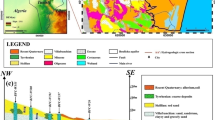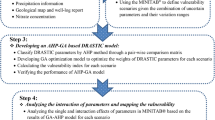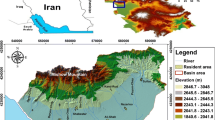Abstract
Accurate identification of vulnerability areas is critical for groundwater resources protection and management. The present study employed the modified DRASTIC model to assess the groundwater vulnerability of Jianghan Plain, a major farming area in central China. DRASTICL model was developed by incorporating the land use factor to the original model. The ratings and weightings of the selected parameters were optimized by analytic hierarchy process (AHP) method and genetic algorithms (GAs) method, respectively. A combined AHP–GAs method was proposed to further develop this methodology. The unity-based normalization process was employed to categorize the vulnerability maps into four types, such as very high (>0.75), high (0.5–0.75), low (0.25–0.5), and very low (<0.25). The accuracy of vulnerability mapping was validated by Pearson’s correlation coefficient between vulnerability index and the nitrate concentration in groundwater and analysis of variance F statistic. The results revealed that the modified DRASTIC model had a large improvement over the conventional model. The correlation coefficient increased significantly from 41.07 to 75.31% after modification. Sensitivity analysis indicated that the depth to groundwater with 39.28% of mean effective weight was the most critical factor affecting the groundwater vulnerability. The developed vulnerability model proposed in this study could provide important objective information for groundwater and environmental management at local level and innovation for international researchers.








Similar content being viewed by others
References
Al-Hanbali A, Kondoh A (2008) Groundwater vulnerability assessment and evaluation of human activity impact (HAI) within the Dead Sea groundwater basin, Jordan. Hydrogeol J 16:499–510
Aller L, Bennett T, Lehr J, Petty R, Hackett G (1987) DRASTIC: a standardized system for evaluating groundwater pollution potential using hydrogeologic settings. EPA, Washington, EPA-600/2-87-035
Baalousha H (2010) Assessment of a groundwater quality monitoring network using vulnerability mapping and geostatistics: A case study from Heretaunga Plains, New Zealand. Agric Water Manag 97:240–246
Babiker IS, Mohamed MA, Hiyama T, Kato K (2005) A GIS-based DRASTIC model for assessing aquifer vulnerability in Kakamigahara Heights, Gifu Prefecture, central Japan. Sci Total Environ 345:127–140
Chakravarty S, Mohanty A, Ghosh B, Tarafdar M, Aggarwal SG, Gupta PK (2013) Proficiency testing in chemical analysis of iron ore: comparison of statistical methods for outlier rejection. Mapan 29:87–95
Chen J, Sun X, Ma T, Zhang W (1985) A preliminary study on environmental geology of cold spring paddy soil in Jinaghan Plain, Hubei Province (in Chinese). Hubei Institute of Hydrogeology and Engineering Geology, Wuhan
Chitsazan M, Akhtari Y (2008) A GIS-based DRASTIC model for assessing aquifer vulnerability in Kherran Plain, Khuzestan, Iran. Water Resour Manag 23:1137–1155
Duan Y, Gan Y, Wang Y, Deng Y, Guo X, Dong C (2015) Temporal variation of groundwater level and arsenic concentration at Jianghan Plain, central China. J Geochem Explor 149:106–119
Gan Y, Wang Y, Duan Y, Deng Y, Guo X, Ding X (2014) Hydrogeochemistry and arsenic contamination of groundwater in the Jianghan Plain, central China. J Geochem Explor 138:81–93
Giacobbo F, Marseguerra M, Zio E (2002) Solving the inverse problem of parameter estimation by genetic algorithms: the case of a groundwater contaminant transport model. Ann Nucl Energy 29:967–981
Gogu RC, Dassargues A (2000) Sensitivity analysis for the EPIK method of vulnerability assessment in a small karstic aquifer, southern Belgium. Hydrogeol J 8:337–345
Guan Y, Zhang L, Hu X, Xiang J, Wang F (2016) National survey and evaluation groundwater and environment in Jianghan–Dongting Plain (in Chinese). Hubei Institute of Hydrogeology and Engineering Geology, Wuhan
Haddad M, Hachemi H, Taibi H (2015) Assessment of Gravity Anomaly Surfaces (DTU10, EGM2008 and ITG-Goce02) in Western Mediterranean Sea. Mediterr J Model Simul 3:87–99
Hernández-Espriú A et al (2014) The DRASTIC-Sg model: an extension to the DRASTIC approach for mapping groundwater vulnerability in aquifers subject to differential land subsidence, with application to Mexico City. Hydrogeol J 22:1469–1485
Holland JH (1975) Adaptation in natural and artificial systems: an introductory analysis with applications to biology, control, and artificial intelligence. University of Michigan Press, Michigan
Huan H, Wang J, Teng Y (2012) Assessment and validation of groundwater vulnerability to nitrate based on a modified DRASTIC model: a case study in Jilin City of northeast China. Sci Total Environ 440:14–23
Javadi S, Kavehkar N, Mohammadi K, Khodadadi A, Kahawita R (2011a) Calibrating DRASTIC using field measurements, sensitivity analysis and statistical methods to assess groundwater vulnerability. Water Int 36:719–732
Javadi S, Kavehkar N, Mousavizadeh MH, Mohammadi K (2011b) Modification of DRASTIC model to map groundwater vulnerability to pollution using nitrate measurements in agricultural areas. J Agric Sci Technol 13:239–249
Lin Z, Yang C (1996) Evaluation of machine selection by the AHP method. J Mater Process Technol 57:253–258
Liu J, S-Y Wang, D-M Li (2014) The analysis of the impact of land-use changes on flood exposure of Wuhan in Yangtze River Basin, China. Water Resour Manage 28:2507–2522
Montgomery DC (2008) Design and analysis of experiments, 7th edn. Wiley, New York
Napolitano P, Fabbri AG (1996) Single-parameter sensitivity analysis for aquifer vulnerability assessment using DRASTIC and SINTACS. In: Paper presented at the HydroGIS 96: application of geographical information systems in hydrology and water resources management, Proceedings of Vienna conference, April 1996
Neshat A, Pradhan B, Pirasteh S, Shafri HZM (2013) Estimating groundwater vulnerability to pollution using a modified DRASTIC model in the Kerman agricultural area, Iran. Environ Earth Sci 71:3119–3131
Neshat A, Pradhan B, Dadras M (2014) Groundwater vulnerability assessment using an improved DRASTIC method in GIS. Resour Conserv Recycl 86:74–86
Neukum C, Azzam R (2009) Quantitative assessment of intrinsic groundwater vulnerability to contamination using numerical simulations. Sci Total Environ 408:245–254
Rahimi S, Shadman Roodposhti M, Ali Abbaspour R (2014) Using combined AHP–genetic algorithm in artificial groundwater recharge site selection of Gareh Bygone Plain, Iran. Environ Earth Sci 72:1979–1992
Saaty TL (1980) The analytic hierarchy process. McGraw-Hill, New York
Secunda S, Collin ML, Melloul AJ (1998) Groundwater vulnerability assessment using a composite model combining DRASTIC with extensive agricultural land use in Israel’s Sharon region. J Environ Manage 54:39–57
Sener E, Davraz A (2012) Assessment of groundwater vulnerability based on a modified DRASTIC model, GIS and an analytic hierarchy process (AHP) method: the case of Egirdir Lake basin (Isparta, Turkey). Hydrogeol J 21:701–714
Sener E, Sener S, Davraz A (2009) Assessment of aquifer vulnerability based on GIS and DRASTIC methods: a case study of the Senirkent-Uluborlu Basin (Isparta, Turkey). Hydrogeol J 17:2023–2035
Shirazi SM, Imran HM, Akib S, Yusop Z, Harun ZB (2013) Groundwater vulnerability assessment in the Melaka State of Malaysia using DRASTIC and GIS techniques. Environ Earth Sci 70:2293–2304
Thirumalaivasan D, Karmegam M, Venugopal K (2003) AHP–DRASTIC: software for specific aquifer vulnerability assessment using DRASTIC model and GIS. Environ Model Softw 18:645–656
Yalcin A, Reis S, Aydinoglu AC, Yomralioglu T (2011) A GIS-based comparative study of frequency ratio, analytical hierarchy process, bivariate statistics and logistics regression methods for landslide susceptibility mapping in Trabzon, NE Turkey. Catena 85:274–287
Yin L, Zhang E, Wang X, Wenninger J, Dong J, Guo L, Huang J (2012) A GIS-based DRASTIC model for assessing groundwater vulnerability in the Ordos Plateau, China. Environ Earth Sci 69:171–185
Zhang T, Chen S, Fu J (2014a) Analysis of three-nitrogen concentration and spatial-temporal distribution of groundwater in Sihu Region (in Chinese). Resour Environ Yangtze Basin 23:1295–1330
Zhang W, Gao L, Jiao X, Yu J, Su X, Du S (2014b) Occurrence assessment of earth fissure based on genetic algorithms and artificial neural networks in Su-Xi-Chang land subsidence area, China. Geosci J 18:485–493
Zhao D, Liu Z, Xiong Q (2007) The vulnerability evaluation for groundwater pollution in Jianghan Plain (in Chinese). Resour Environ Eng 21:62–67
Zhou Y, Wang Y, Li Y, Zwahlen F, Boillat J (2012) Hydrogeochemical characteristics of central Jianghan Plain, China. Environ Earth Sci 68:765–778
Acknowledgements
This work was supported by China Geological Survey (Nos. 1212011121142 and 1212011120084). The authors would like to thank Dr. Quanrong Wang and the three anonymous reviewers for their valuable suggestions which greatly improve the quality of the manuscript.
Author information
Authors and Affiliations
Corresponding author
Rights and permissions
About this article
Cite this article
Yang, J., Tang, Z., Jiao, T. et al. Combining AHP and genetic algorithms approaches to modify DRASTIC model to assess groundwater vulnerability: a case study from Jianghan Plain, China. Environ Earth Sci 76, 426 (2017). https://doi.org/10.1007/s12665-017-6759-6
Received:
Accepted:
Published:
DOI: https://doi.org/10.1007/s12665-017-6759-6




